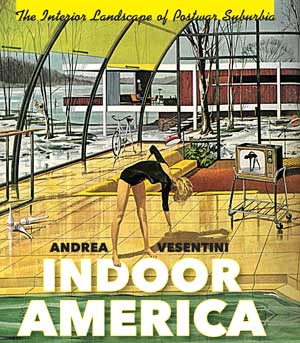
There is no question that suburbs are one of the defining features of the U.S. urban landscape, as well as the place where most Americans have spent their lives since the end of World War II. The interiors of cars, single-family houses and shopping malls are the everyday environment inhabited by the majority of the population. Indoor America looks at these all-too-familiar spaces through a novel point of view that twists the cliché of lawns and backyards to chronicle how suburbia grew into a landscape of interconnected interiors. As such, it is a cultural history that takes as its primary focus the postwar era, roughly from 1945 to 1969, a time that coincides with the apex of the suburban exodus.
Although there is a great number of books on the history of suburbanization, none has focused on the predominant role that interior spaces play in the daily life of residents, and how this state of things came to be. The rise of suburbia since the end of the war is thus retold by placing the pursuit of interiors at its center, exploring how all such spaces, from automobiles to indoor shopping centers, functioned as escape capsules affording a higher degree of segregation and insulation from the perceived threats of urban life. Needless to say, the fears that drove people out of the city and into the protective network of suburban interiors often stemmed from the inability to deal with an increasingly racially mixed city, the tensions that this diversity entailed, and the profound social changes of those decades.
In the book, interiors are understood in the broadest possible sense: the domestic space of single-family houses, of course, but also cars, shopping malls, with detours into the fallout-shelter craze of the nuclear age, air conditioning, and plans for completely enclosed cities in the late 1960s. The narrative is structured as a journey across all such defensive shells. It starts from the increasing popularity of the closed-body car in the 1920s (when private transportation became the norm) and ends on the macro-interiors of indoor city proposals, such as the unbuilt Minnesota Experimental City project, Walt Disney’s EPCOT, and Paolo Soleri’s Arcologies.
The greatest challenge in writing a cultural history is that its primary object of study is incredibly hard to pin down. The focus should not only be on the materiality of architectural spaces but also on the sociocultural forces that originated them. Although some historians are led to disqualify the validity of cultural studies as a methodology exactly because of the intrinsically indefinable nature of its subject of analysis, I soon realized there was no other way to address this topic if not by approaching it from several fronts.
In Indoor America, the interest is not just on interiors as built spaces that were designed by architects, built by developers, and inhabited by real people, but also on interiors as a state of mind. Fallout shelters, for example, to which an entire chapter is devoted, mostly came alive as imagined spaces in popular culture given that only a handful were completed. However, the fact that they were a hotly debated issue for years, as well as their widespread representation in civil defense films, design manuals, and widely distributed magazines, left a mark on Americans’ imagination if not on the landscape they physically inhabited. Therefore, they cast an influence on the way domestic and public interiors were conceived. Their greatest legacy is not found in the built environment, but this does not mean that they are not part of the country’s architectural history.
The multifaceted aspects of this cultural landscape brought me to the conclusion that, in order to tell such a history, I had to take into account the design of all such interiors, as well as their depiction on a variety of media, ranging from advertising to films. Beatriz Colomina’s book Domesticity at War was unquestionably the first source of inspiration. When I first came across it, I could not let go of it. The way in which postwar architectural history was told through images captured me in a way probably no other book ever has, drawing me into an age I had never experienced firsthand. I was not just presented with the events that happened in those years, the places that got built, and the architects that designed them. I could almost smell those interiors, walk into those houses, hear the sound of TV commercials. I wanted Indoor America to also construct a sort of inhabitable landscape, and thus images took center stage in the analysis. They are not just brought into the discussion as documents, but as mysterious texts to be deciphered, rooms to be unlocked and explored.
I also wanted the book to provide a bigger picture of suburbanization that could explain why this phenomenon happened in a certain place and a certain time. There is a wealth of scholarship evidencing the financial and political support of suburbanization against other forms of urban growth in the postwar years, but I felt still too little had been written about the deeper motives that justified such backing. My purpose was to uncover the cultural needs accounting for the extensive consensus around suburbanization. The aim was to single out the causes that made suburbia and its interior landscape desirable in the eyes of the majority. The undisputed reference text on the history of American suburbs, Kenneth T. Jackson’s Crabgrass Frontier, was published over thirty years ago; I thought the time was ripe to rewrite this story, keeping the broad focus of Jackson’s book, but from a completely different angle.
The chapter also gives a sense of the peculiar methodology used to write about suburban interiors as a cultural landscape. Transparency in architecture is addressed through the analysis of actual buildings, such as Richard Neutra’s modernist houses and Cliff May’s ranches in Los Angeles, but also through imaginary spaces. There is one section examining the role of windows in urban and suburban sitcom narratives like I Love Lucy and The Goldbergs, and another on the depiction of picture windows in Douglas Sirk’s film All That Heaven Allows.
The first chapter on the rise of the car in the interwar years, a phenomenon that paved the ground for postwar suburban sprawl, is another part that should not be missed in order to understand the driving forces behind suburbanization. The mass relocation of Americans further and further away from the center of cities has often been referred to as “white flight” by many historians and commentators. This term is derived from the fact that most of those who left the city for suburbia were white Americans at a time when the number of African Americans moving into the metropolitan core was on the rise. There is no doubt about the segregationist motives behind the growth of suburbs, but segregation was pursued in several ways besides taking up residence in a newly built subdivision. The very infrastructure of automobile transportation, which is the connecting tissue of the sprawling American city, was devised as a public space that individuals could share without coming into contact with each other thanks to the car’s protective interior, a form of microsurgical segregation.
I hope Indoor America will speak to a wide audience that is interested in different aspects of America’s urban and cultural history. As the current state of U.S. cities makes evident, the development of a self-sufficient interior landscape in the postwar years as the setting of private and public life for most Americans (what we might call the car-garage-house-office-mall complex) did not come without consequences. The steady decline of public transportation, street life, and livable public places that are not owned and run by private companies has contributed to exacerbating and reproducing social inequalities. There is still too little attention paid to architectural preservation, to safeguarding public places from private interests, or to making cities into inclusive places whose spaces can be shared by people from all backgrounds.
There are two directions one can look to for improvement: backward and outward. Americans should be encouraged to look outside their country for examples of sound urbanism that has fostered more equal, inclusive and safe communities. To look backward, instead, is to learn from history and turn it into a powerful tool to guide future decisions. Although the book focuses on events that happened long ago and already had an impact on the country’s landscape, future urban policies should be informed by a deeper knowledge of the past and of the long-lasting effects of postwar urban visions.
I see this book as a story whose ending is still to be written. There are contrasting views among sociologists and urban analysts on whether suburbanization is still under way, or cities are making a comeback with the gentrification of some central areas. However, little progress would be made if places are still designed as defensive oases of privilege and exclusion in the future. Separation and segregation only breed further separation and segregation, ultimately bringing a city’s life to an end. I hope that readers will get a sense of where and how things might have gone differently in the past, and of how much can still be done to improve the state of America’s urban life in the years to come.


Andrea Vesentini is a cultural historian specializing in American architecture and urban studies. He holds a Ph.D. in Humanities and Cultural Studies from Birkbeck College, University of London, where he also taught literature and cultural studies. He has been working since 2016 for the Architecture, Visual Arts and Film departments of La Biennale di Venezia. He presented his research at several universities and institutions such as London’s Institute of Contemporary Arts and Science Museum, the John F. Kennedy Institute for North American Studies at Freie Universität Berlin, and the Amsterdam Centre for Architecture. His first book, Indoor America: the Interior Landscape of Postwar Suburbia, has been published in 2018 by the University of Virginia Press.